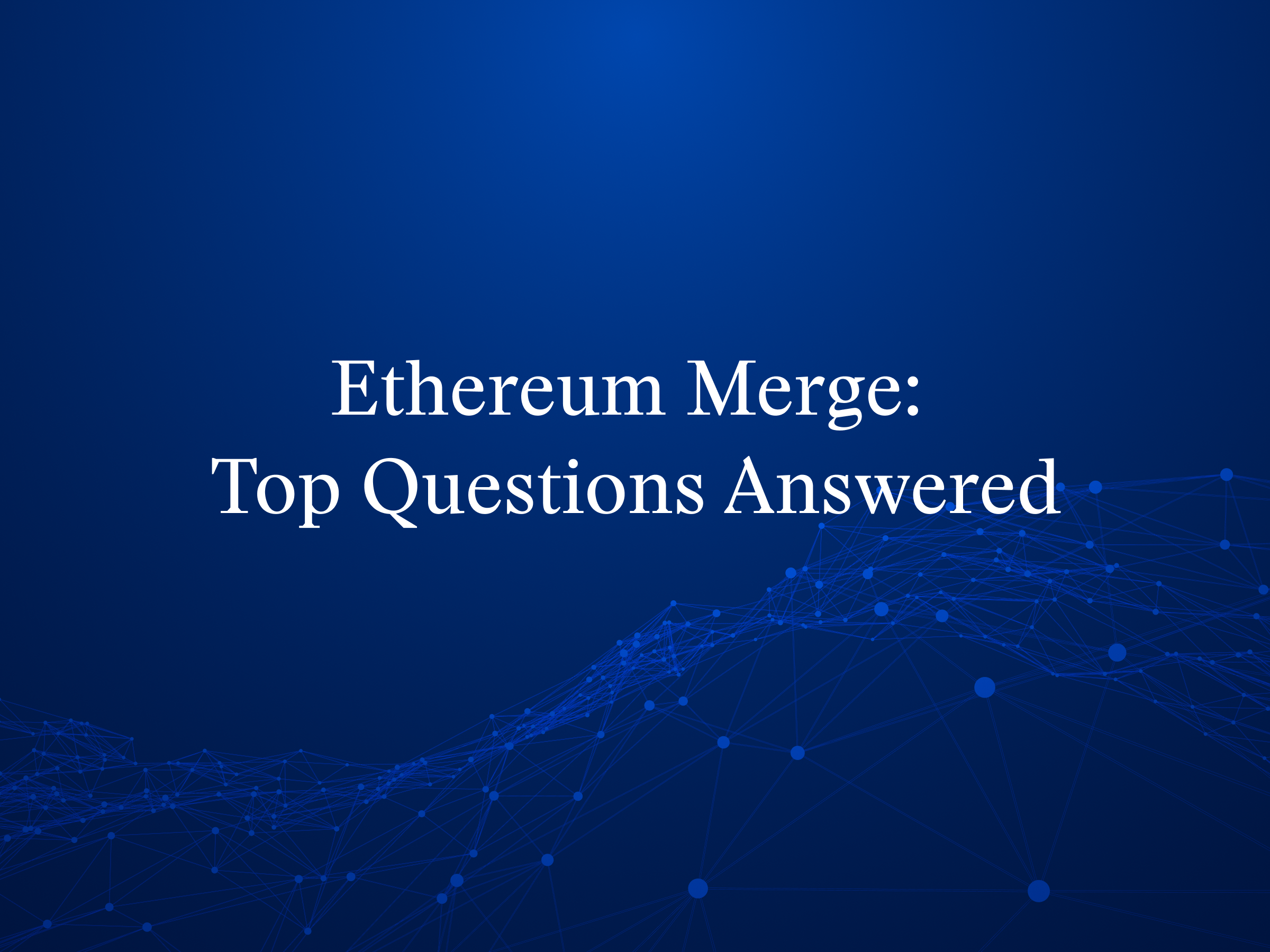TL;DR
The Ethereum mainnet will shift from a Proof-of-Work to a Proof-of-Stake consensus mechanism in an upgrade called The Merge. The Merge is part of a series of major Ethereum upgrades, which also include The Surge, The Verge, The Purge, and The Splurge. The goal of these upgrades is to make Ethereum more scalable and energy efficient.
sFOX is excited to announce that it will support the Ethereum Merge. ETH deposits and withdrawals on the sFOX platform are expected to be temporarily paused for a period of time during the Merge as a precautionary measure.
Despite a volatile summer with the downward spiral of the Terra Ecosystem and major crypto lending platforms Celsius, BlockFi, Voyager, and Vault taking measures to accommodate for the market conditions, crypto assets have since rebounded with BTC closing August +14% and ETH +76.6% off the June low.
One of the main contributors to the rebound is the long-awaited Ethereum Merge. Ethereum developers announced that Merge could occur as soon as September 2022, moving Ethereum activity over to the Beacon Chain and transitioning completely from Proof-of-Work to Proof-of-Stake.
Ethereum Merge is probably the most significant event to happen in 2022 within the crypto ecosystem and much of the hype is around how it may affect Ethereum’s price, although the real excitement lies in the technological improvement.
In this blog post, we want to summarize all you need to know about the Merge.
1. What is the Merge
Currently, the Ethereum blockchain runs on a Proof-of-Work model. The upgrade, or Merge, will transition Ethereum to the Proof-of-Stake model. To ensure the Proof-of-Stake chain would operate smoothly before launching it to the public, Ethereum developers launched it as a separate Beacon chain. The Merge is when the Beacon chain merges with the current Proof-of-Work chain Mainnet, completing the shift to Proof-of-Stake. The plan is to do this instantaneously with no network downtime, which has already been done successfully on all of the Ethereum testnets.
2. What are Proof-of-Work and Proof-of-Stake
Proof-of-Work (PoW) and Proof-of-Stake (PoS) are the most common consensus mechanisms on the blockchain. The major difference between the two is the way they determine who gets to validate a block of transactions.
PoW is used to validate peer-to-peer transactions that are verified by miners, participants that use a great number of resources to ensure the network continues to run securely and correctly. Among other tasks, miners propose blocks of transactions to be validated by nodes, using highly specialized mining hardware to perform sufficient valid work.
PoS is a consensus algorithm introduced in 2011 as an alternative to Proof-of-Work. It aims to overcome the scalability limitations of PoW networks. There are no miners on PoS blockchains and validators rely on their crypto holdings. To be eligible to validate a block, participants need to lock a certain amount of coins in a specific smart contract on the blockchain. This process is known as staking.
3. Why Switch to Proof-of-Stake
Proponents highlight three main reasons:
- Significantly less energy usage,
- Higher security and decentralization, and
- Reduced ETH inflation rate.
Proof-of-Work is trusted and reliable. One common critique is energy consumption. It secures the network by having the miners work to produce a hash with sufficient difficulty to serve as the next block of transactions. If the miners solve the problem, they get rewarded with Ether or Bitcoin or whatever token the network uses. Those operations require huge investments in hardware and electricity as they consume an exorbitant amount of power. That is one of the biggest advantages of the Merge. When Ethereum switches from Proof-of-Work to Proof-of-Stake – there won’t be any need for massive mining operations, and energy usage will drop by an estimated 99.95%.
The Proof-of-Stake consensus mechanism takes a different approach and replaces mining power for staking. This mechanism lowers the barriers to entry for an individual to become a block producer, reducing the emphasis on location, equipment, and other factors.
One of the core components of proof-of-stake is a validator. Like miners on Proof-of-Work, validators are responsible for processing transactions on Ethereum and, by doing so, helping secure the network. All you need to become a block producer is 16 to 32 ETH and some reasonable computer hardware. So the PoS network is intended to be more accessible for anyone who wants to help validate it, which should increase the number of network participants helping ensure its security and decentralization. Unless an attacker controls at least 51% of the blockchain’s staking tokens and simultaneously controls at least 51% of the network’s nodes, it is extremely unlikely for them to carry out a successful attack. Any bad actors will have their stakes slashed.
Currently, the Ethereum Proof-of-Work network pays miners approximately 13,000 ETH daily. This is the other reason why the Merge is so exciting from a financial perspective: after the Merge, the reward will drop by around 90%, significantly reducing the inflation rate of Ethereum.
4. What are the misconceptions about the Merge
The Merge is a change of consensus mechanism, not an expansion of network capacity. Therefore, Ethereum gas fees will remain the same for now. In theory, the Ethereum upgrade sets the stage for sharding, which opens up possibilities for cheaper gas fees in the future.
Second, transactions will not go through faster. This is also in line with Ethereum’s goals to be a security and settlement layer instead of a high-speed transaction chain.
Thirdly, stakers won’t be able to withdraw their staked ETH for six to twelve months after The Merge. Estimators predict a 50% increase in APR (Annual Percentage Rate) post-merge.
5. Dates to know
According to Coindesk – The Ethereum Merge Has an Official Kick-Off Date – the Bellatrix upgrade will activate on the Beacon Chain on September 6, 2022. This upgrade is responsible for setting the rest of the Merge process in motion. The Merge itself will be completed at some point on September 13-20, 2022.
6. What comes next
The Merge is only the beginning: Ethereum will then undergo further upgrades which Vitalik Buterin calls the “Surge,” “Verge,” “Purge,” and “Splurge.”
Bitcoin advocates consider Bitcoin to be 80% complete. Ethereum supporters believe Ethereum is just 40% complete. After the Merge, Ethereum will still only be roughly 55% complete.
The Surge refers to the addition of Ethereum Sharding, a scaling solution that the Ethereum Foundation claims will further enable cheap layer-2 blockchains and will process transactions faster, moving from 15-20 transactions a second to 100,000 transactions a second.
The Verge will implement what Buterin calls “Verkle trees,” a type of mathematical proof that allows users to become network validators without having to store extensive amounts of data on their machines.
The Purge aims to simplify the Ethereum protocol over time and not require nodes to store history, cutting down the amount of hard drive space required for validators. Reducing the amount of historical data will make the process of validating the blockchain more efficient.
Buterin has described the next part, the Splurge as “the fun stuff.” It aims to make sure that the network continues to run smoothly and that the updates to the protocol in the previous sections do not cause any issues.
sFOX is prepared for the Merge and is aiming to ensure a seamless migration for clients. We will be closely monitoring any developments and will provide more information in upcoming announcements.



